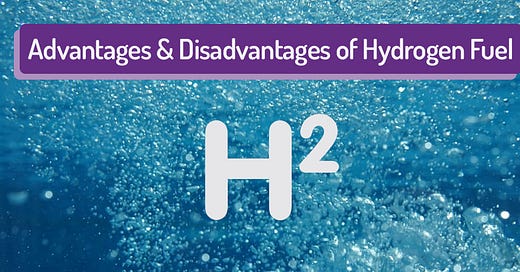Developed nations revolve around energy systems, without which we cannot survive extreme temperatures, have light at night, communicate over distances, travel, deliver water, grow food or manufacture things. Dependence on fossil fuels alone is failing to meet our needs and damages the environment at many levels. We need more efficient, affordable, and sustainable systems that minimize negative impacts on nature’s ecosystems. Hydrogen is the most abundant element in the universe and its use has the potential to transform our world. It has three times as much energy as fossil fuels, which is one reason it is used in spacecraft.
Hydrogen rarely exists as a single gas on Earth and is almost always combined with other elements – water for example. Molecular hydrogen, H2, can be generated from diverse resources and processes, including fossil fuels, biomass, geothermal, nuclear, and renewable energies. Currently, around half of the world’s industrial hydrogen comes from natural gas (methane) and is used for fertilizers, making iron and steel, and space propulsions. When burnt or oxidized, it becomes a colorless, clean fuel that emits only water. However, extracting hydrogen from natural gas does create CO2, so other ways of producing it as Blue or Green Hydrogen are being researched and developed.
Blue Hydrogen is the industrial term for hydrogen produced by natural gas supported by carbon capture and storage (CCS). One process, called steam reforming, combines natural gas and heated water in the form of steam. Other methods include electrolysis of water through fission and fusion, photolytic splitting of water, biomass fermentation, and gasification or partial oxidation of coal and oil. The released carbon from these processes can then be applied to other uses, such as injecting it into the ground at oil reservoirs or thermal generation plants or making industrial chemicals like methanol. It’s all about industrial recycling.
Green Hydrogen is produced by renewable energies such as wind or solar with no CO2 as a by-product. Blue ammonia is made from nitrogen with carbon capture, whereas Green Ammonia uses Green Hydrogen produced by water electrolysis. Nitrogen-based fertilizers used in agriculture are made by combining blue hydrogen and nitrogen from the air at high temperatures to create ammonia. The ammonia is then mixed with nitric acid to produce nitrate fertilizer. Russia is the largest exporter of fertilizers, using its natural gas resources, which is composed of 70 to 90 percent methane.
Ultimately, in order to achieve a truly sustainable hydrogen energy economy, we must produce hydrogen from non-fossil fuel resources, principle among them being water. Hydrogen can be produced by splitting water through various processes, including electrolysis, photo- electrolysis, high temperature steam, and photo-biological splitting. Currently, it is still less expensive to use fossil fuels though. The holy grail of hydrogen production may be in harvesting sunlight through a photolytic process to split water without the use of electricity.
Hydrogen can be used in devices called fuel cells, converting hydrogen directly into electricity with high efficiency far greater than traditional combustion engines. Fuel cell engines operate at up to 85% efficiency across most output power ranges, compared to 25% for most petrol-driven vehicles. Hydrogen fuel cells emit only water with virtually no pollutants. Major vehicle manufacturers are heavily investing in fuel cell vehicles, making California’s plan for lithium battery electric cars wasteful and ignorant of existing technology.
Hydrogen can be used as a storage medium for electricity generated from intermittent supply resources such as solar, wind and tidal power. It can be stored physically as either a gas or as a liquid. Storage applications are stationary, portable or for transportation. It has the highest energy per mass of any fuel but its low ambient temperature density requires advanced technology for storage. Research has been conducted by the US Department of Energy and other nations to develop novel storage materials.
A significant technical hurdle in using hydrogen energy is transporting it. Hydrogen can be liquefied, but that requires it to be kept at a temperature of -254o C, making it very difficult and expensive to transport. The solution is converting the hydrogen into a chemical compound widely traded around the world – ammonia. This turns hydrogen into an energy carrier. Compared to liquified hydrogen, ammonia is far more convenient and practical. Once it reaches its destination, it can be converted back into blue hydrogen or used directly as a fuel for gas turbines for cleaner power.
Saudi Arabia’s conglomerate, Aramco, successfully shipped 40 tons of high-grade blue ammonia to Japan in August 2020. Japan combined the blue ammonia at three existing coal burning plants in the same ratio with natural gas. Japan has the ultimate goal of becoming a decarbonized society. Aramco, along with Japan, China and South Korea, have also begun establishing hydrogen fueling stations for vehicles using fuel cells.
Transition to hydrogen energy has been tried and abandoned over the past few decades. What is different now and or have our needs changed? If fossil fuels were ever to become unavailable or too expensive, then absolutely we must pursue alternatives. Hydrogen power first gained traction during the crude oil embargo of the 1970’s. Current sanctions and war with Russia is jeopardizing our oil and gas access, triggering OPEC to shift its alliances Eastward. Or if climate change concerns drive us to aim for New Zero environmental damage, then, yes, we must consider other alternatives. Hydrogen energy depends on producing blue or green pathways and commitment for building the relevant infrastructures and vehicles. Cost will always be part of the picture.





